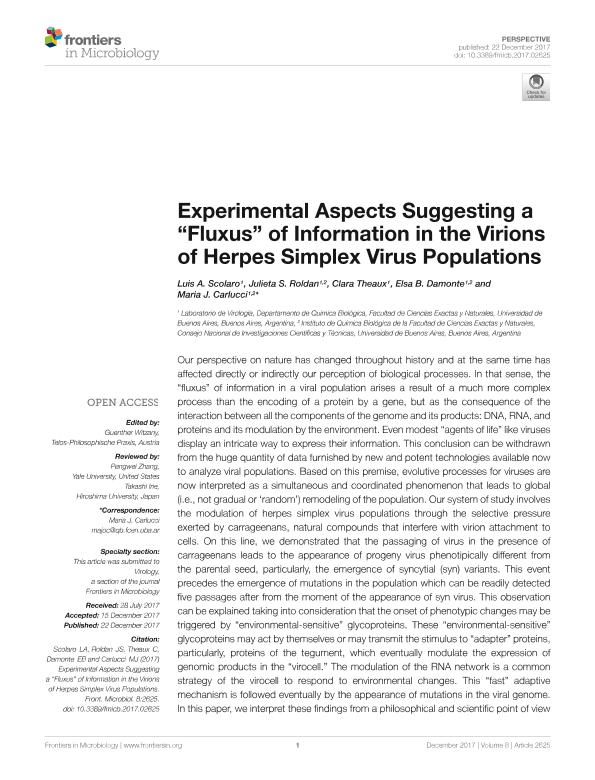Artículo
Experimental aspects suggesting a "fluxus" of information in the virions of herpes simplex virus populations
Scolaro, Luis Alberto ; Roldan, Julieta Suyay
; Roldan, Julieta Suyay ; Theaux, Clara; Damonte, Elsa Beatriz
; Theaux, Clara; Damonte, Elsa Beatriz ; Carlucci, Maria Josefina
; Carlucci, Maria Josefina
 ; Roldan, Julieta Suyay
; Roldan, Julieta Suyay ; Theaux, Clara; Damonte, Elsa Beatriz
; Theaux, Clara; Damonte, Elsa Beatriz ; Carlucci, Maria Josefina
; Carlucci, Maria Josefina
Fecha de publicación:
12/2017
Editorial:
Frontiers Research Foundation
Revista:
Frontiers in Microbiology
ISSN:
1664-302X
Idioma:
Inglés
Tipo de recurso:
Artículo publicado
Clasificación temática:
Resumen
Our perspective on nature has changed throughout history and at the same time has affected directly or indirectly our perception of biological processes. In that sense, the "fluxus" of information in a viral population arises a result of a much more complex process than the encoding of a protein by a gene, but as the consequence of the interaction between all the components of the genome and its products: DNA, RNA, and proteins and its modulation by the environment. Even modest "agents of life" like viruses display an intricate way to express their information. This conclusion can be withdrawn from the huge quantity of data furnished by new and potent technologies available now to analyze viral populations. Based on this premise, evolutive processes for viruses are now interpreted as a simultaneous and coordinated phenomenon that leads to global (i.e., not gradual or 'random') remodeling of the population. Our system of study involves the modulation of herpes simplex virus populations through the selective pressure exerted by carrageenans, natural compounds that interfere with virion attachment to cells. On this line, we demonstrated that the passaging of virus in the presence of carrageenans leads to the appearance of progeny virus phenotipically different from the parental seed, particularly, the emergence of syncytial (syn) variants. This event precedes the emergence of mutations in the population which can be readily detected five passages after from the moment of the appearance of syn virus. This observation can be explained taking into consideration that the onset of phenotypic changes may be triggered by "environmental-sensitive" glycoproteins. These "environmental-sensitive" glycoproteins may act by themselves or may transmit the stimulus to "adapter" proteins, particularly, proteins of the tegument, which eventually modulate the expression of genomic products in the "virocell." The modulation of the RNA network is a common strategy of the virocell to respond to environmental changes. This "fast" adaptive mechanism is followed eventually by the appearance of mutations in the viral genome. In this paper, we interpret these findings from a philosophical and scientific point of view interconnecting epigenetic action, exerted by carragenans from early RNA network-DNA interaction to late DNA mutation. The complexity of HSV virion structure is an adequate platform to envision new studies on this topic that may be complemented in a near future through the analysis of the genetic dynamics of HSV populations.
Archivos asociados
Licencia
Identificadores
Colecciones
Articulos(IQUIBICEN)
Articulos de INSTITUTO DE QUIMICA BIOLOGICA DE LA FACULTAD DE CS. EXACTAS Y NATURALES
Articulos de INSTITUTO DE QUIMICA BIOLOGICA DE LA FACULTAD DE CS. EXACTAS Y NATURALES
Citación
Scolaro, Luis Alberto; Roldan, Julieta Suyay; Theaux, Clara; Damonte, Elsa Beatriz; Carlucci, Maria Josefina; Experimental aspects suggesting a "fluxus" of information in the virions of herpes simplex virus populations; Frontiers Research Foundation; Frontiers in Microbiology; 8; DEC; 12-2017; 1-6
Compartir
Altmétricas



